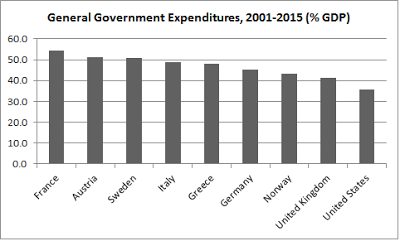Summary:
Source: WEO, IMF Nothing earth shattering. Just the size of the average government spending as a share of GDP between 2001 and 2015 in a few developed countries, all of which, but one, have comprehensive health coverage. So it's reasonable to assume that if the US wanted that (healthcare for all), it would have to increase spending to something closer to 40% of GDP, for all levels of government, rather than the current 35% or so. Nothing implausible about that (wink, wink, nudge, nudge, say no more).
Topics:
Matias Vernengo considers the following as important: Health Insurance, Size of government
This could be interesting, too:
Source: WEO, IMF Nothing earth shattering. Just the size of the average government spending as a share of GDP between 2001 and 2015 in a few developed countries, all of which, but one, have comprehensive health coverage. So it's reasonable to assume that if the US wanted that (healthcare for all), it would have to increase spending to something closer to 40% of GDP, for all levels of government, rather than the current 35% or so. Nothing implausible about that (wink, wink, nudge, nudge, say no more).
Topics:
Matias Vernengo considers the following as important: Health Insurance, Size of government
This could be interesting, too:
Dean Baker writes Health insurance killing: Economics does have something to say
Jodi Beggs writes Access to Birth Control Versus Affordable Birth Control- Choose Wisely…
James Kwak writes How Markets Work
James Kwak writes How Markets Work
Source: WEO, IMF
Nothing earth shattering. Just the size of the average government spending as a share of GDP between 2001 and 2015 in a few developed countries, all of which, but one, have comprehensive health coverage. So it's reasonable to assume that if the US wanted that (healthcare for all), it would have to increase spending to something closer to 40% of GDP, for all levels of government, rather than the current 35% or so. Nothing implausible about that (wink, wink, nudge, nudge, say no more).

